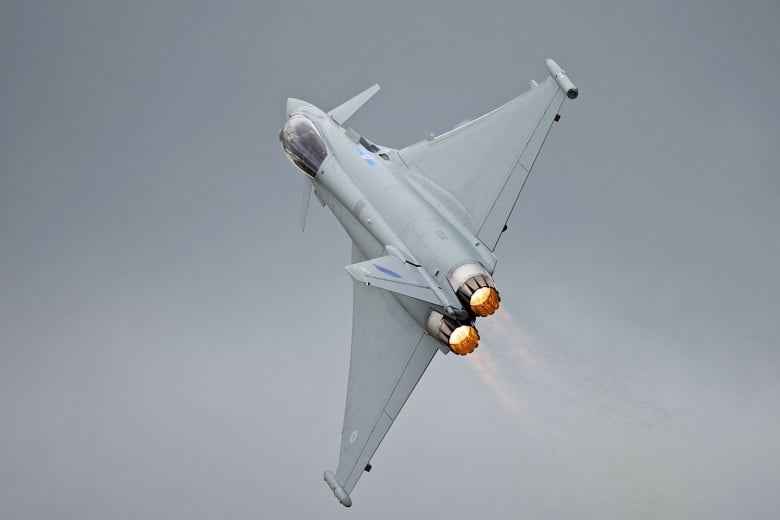You Can't Stop the Eurofighter Typhoon Fighter
The Eurofighter Typhoon, a product of European collaboration between Germany, Italy, the UK, and later Spain, was designed to rival Soviet aircraft capabilities. Launched in 1986, it leveraged advanced features like canard foreplanes, carbon-fiber composites, and a digital fly-by-wire system, ensuring enhanced maneuverability and stealth.
What You Need to Know: The Eurofighter Typhoon, a product of European collaboration between Germany, Italy, the UK, and later Spain, was designed to rival Soviet aircraft capabilities. Launched in 1986, it leveraged advanced features like canard foreplanes, carbon-fiber composites, and a digital fly-by-wire system, ensuring enhanced maneuverability and stealth.

-Equipped with Captor-M radar, the Typhoon excels in multi-target tracking and air combat acquisition. Its EJ200 engines allow supersonic cruise without afterburners, and HOTAS controls reduce pilot workload.
-Since its 1994 prototype, over 570 Typhoons have been delivered, remaining essential in European and Gulf air forces and underscoring Europe’s capability in fighter aircraft innovation.
Eurofighter Typhoon: Europe’s Advanced Jet Fighter That Rivals the Best
There was a time when the idea of a joint European-built aircraft was little more than a pipe dream. Still, the European collaborative program that produced the Panavia Tornado proved that former adversaries could work well together in developing a highly capable warbird.
The Eurofighter Typhoon was devised to provide four of the continent’s air forces with an air defense fighter that would be superior in all respects to the latest generation of Soviet warplanes then coming online.
Eurofighter: A History
Established in June 1986, the Eurofighter consortium involved the same three countries – Germany, Italy and the UK – that had worked to develop the Panavia Tornado.
Spain later joined those three, while France had also been an early partner in the European Fighter Aircraft (EFA), before Paris elected to pursue its own program that resulted in the development of the Dassault Rafale.
Early work on the EFA project had actually defined the basic concepts for the future Eurofighter Typhoon, including canard foreplanes, active digital fly-by-wire controls, extensive use of carbon fiber composites and other advanced materials, a hands on throttle and stick (HOTAS) cockpit, advanced avionics, multi-function cockpit displays and direct voice command input.

Many of the technologies had been tested using a full-scale demonstrator, the British Aerospace (BAe) EAP (Experimental Aircraft Programme). Seven prototypes were produced, and the first made its maiden flight in March 1994.
The aircraft was subsequently re-designated the Eurofighter 2000, and later renamed Eurofighter Typhoon.
Notable Eurofighter Typhoon Facts
The Captor-M mechanically scanned radar’s wide field of regard offered significant benefits in both air-to-air and air-to-surface engagements. It provided considerable power and aperture for enhanced angular coverage.
A multi-mode unit, the Captor-M was able to search for targets in Range While Search (RWS), Velocity Search (VS) and multi-target Track While Scan (TWS) modes. Lock-follow Modes were tailored long-range tracking and short-range tracking for use in visual identification or gun attacks.

In addition, Captor-M’s Air Combat Acquisition Modes could provide the pilot with a choice of boresight, vertical scan HUD field of view or slaved acquisition. The jet fighter offers three advanced search modes: Range While Search, Velocity Search, and Track While Scan. In addition, there is a set of lock-follow modes that provide short and long-range tracking, which can be used in visual and gun attacks.
The pilot workload was reduced by using advanced features, including a direct voice input (DVI) and the hands-on throttle and stick (HOTAS) control functions, which allow single-pilot operations even in the most demanding missions. Navigation aids also included the latest GPS with a fully digital interface, satellite tracking channels, and anti-jam capabilities.
The Eurofighter Typhoon was notable for having only 15 percent of its surface being metallic. That enhanced its stealth and protection against radar-based systems. In all, upwards of 75 percent of the aircraft was fabricated from carbon-fiber composites.
The two-spool EJ200 engines utilized a single-stage turbine driving a three-stage fan and five-stage compressor with annular combustion with vaporizing burners. It enabled cruise at supersonic speeds without afterburning.
The Typhoon also employed a deliberately unstable aerodynamic configuration that provided superior maneuverability at subsonic speeds as well as efficient supersonic capability.
As of October 2020, 572 Eurofighter Typhoons have been delivered. The aircraft remains in service with the air forces of multiple, including Germany, Italy, Spain and the UK – while Austria, Kuwait, Oman, Qatar and Saudi Arabia have also adopted the aircraft.
Currently, four of the surviving prototypes are now on display in museums in Germany, Italy and the UK.
About the Author: Defense Expert Peter Suciu
Peter Suciu is a Michigan-based writer who has contributed to more than four dozen magazines, newspapers and websites. He regularly writes about military hardware, and is the author of several books on military headgear including A Gallery of Military Headdress, which is available on Amazon.com. Peter is also a Contributing Writer for Forbes.
Image Credit: Shutterstock.


